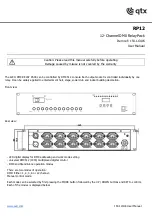
3-2
UR FAMILY – COMMUNICATIONS GUIDE
OVERVIEW
CHAPTER 3: IEC 61850 COMMUNICATION
3
Figure 3-1: IEC 61850 and device overview
The Process block at the bottom of the figure represents power system components monitored and controlled by the IED,
such as circuit breakers, disconnect switches, and current and voltage instrument transformers. These are connected
typically through conventional copper wiring to IEDs, although the possibility exists with some IEDs for connection via
Ethernet communications, such as IEC 61850 process bus. The copper wiring typically connects the IED to status
monitoring mechanical contacts, secondary windings of current and voltage transformers, and trip and close circuits.
These process signals are represented in the figure by the lines connecting the Process block to the Traditional relay
functions block inside the IED.
The Traditional Relay Functions block consist of protection, control, and monitoring functions, such as phasor and root
mean square (RMS) estimators, distance protection elements, overcurrent elements, reclosing, and predictive maintenance
monitors. The input and output signals of these functions (other than the process signals) are represented in the figure by
the lines connecting the Traditional Relay Functions block to the Abstract Communications Service Interface. These signals
are typically Boolean and numeric signals, including FlexLogic operands, FlexAnalog operands, actual values, and UR
settings, and can be communicated between IEDs using IEC 61850 communications.
The Abstract Communication Service Interface (ACSI) block translates the native names of the signals, names that vary in
different manufacturers’ products, to names using a standard naming convention that are to be understood by all IEC
61850 compliant devices. This is also called the information model. The signals with their standard names are called data
attributes, and are represented in the figure by the lines connecting the ACSI block to the Specific Communication Service
Mapping block. The next section details the ASCI block.
The Specific Communication Service Mapping (SCSM) block converts the ACSI signals to/from Ethernet messages, which
are carried by a local area network to/from other IEDs. The standard specifies several "services" for doing the translation,
each of which is designed for different performance/capability needs. The main services, the ones implemented by UR
family devices, are as follows:
















































